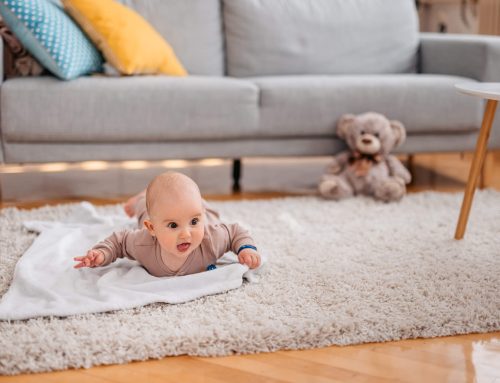
Nine Reasons Why Your House Doesn’t Heat Evenly
Have you experienced irregular home heating this year? This issue happens when some rooms are nice and cozy while others are noticeably colder. There may be several reasons causing this uncomfortable problem. Explore what could be causing these temperature disparities and how to solve them.
1. Your Vents Are Blocked or Closed
The cause of your problems: Your furnace distributes heated air throughout your home via supply and return registers. If these are closed, the impeded airflow creates hot and cold spots in your home.
The fix: Make sure all the vents are clear, especially if certain rooms aren’t receiving enough heat. Then, inspect furniture, rugs and curtains that might be blocking airflow. If a room is too hot, make sure the registers in the other rooms are able to let air flow freely and feel like the same amount of air is coming out. If one or more registers is open but not a lot of air is coming out, there might be a problem with a damper or the duct directing the air to go where it is not needed.
2. Clogged Furnace Filter
The problem: Your furnace air filter collects dust, pollen and other airborne particles, making your air clean. But a dirty filter obstructs airflow, making your heating system strain and causing uneven heating. If warm air is unable to get through the HVAC system easily, rooms farther from the furnace are made colder than you would like.
The fix: Inspect and swap out the air filter for a fresh one every one to three months, especially in the winter when your heating system runs more.
3. Inadequate Insulation
The problem: Inadequate home insulation allows heat to escape, especially from rooms connected to outside walls or the attic. This problem causes certain rooms to be challenging to heat, even when other spaces of the house are comfortable.
The fix: Add more attic insulation to stop heat from seeping out of your home. If your existing insulation looks good, you may be able to install more on top of it.
4. Air Is Escaping Through Windows and Doors
The issue: Single-pane windows and old, drafty doors are infamous for letting cold air inside, disrupting the indoor temperature. This problem is most common in old homes, where windows and doors don’t shut as tightly as they should.
The solution: Reduce drafts around doors and windows by adding weatherstripping or caulk. Insulated curtains and thermal blinds also prevent the cold from entering. If these small fixes aren’t enough to prevent cold spots, think about replacing your windows and exterior doors.
5. Air Is Leaking out of Your Ducts
The issue: Ductwork carries heated air through your home. If there’s a break in the ducts, warmth can leak out of the ductwork before reaching your living space.
The fix: Employ an HVAC specialist to inspect your ductwork for leaks, which can often be repaired with metal tape or mastic sealant. In more serious cases, duct substitution may be necessary.
6. You Need to Move Your Thermostat
The dilemma: Your thermostat regulates the heating system for your entire house. If it’s in a drafty or overly warm location, it may provide inaccurate readings, causing the system to run at the wrong times and resulting in uneven temperatures.
The remedy: If your thermostat is installed near a drafty window or heat-generating appliance, consider relocating it. A professional HVAC technician from McLoughlin Plumbing Heating & Cooling can help you move it to a more centralized location so that it is able to more accurately assess the home’s overall temperature. For extra convenience, consider a smart thermostat, which permits remote temperature control and personalized heating schedules.
7. Your Home’s Furnace System Isn’t the Right Size
The problem: A furnace that’s too small may fail to produce enough heat, leaving some rooms cold. Conversely, a furnace that’s too large may cycle on and off frequently, resulting in temperature fluctuations and increased wear and tear on your heating system.
The fix: Have a professional assess the furnace size in relation to your home’s square footage, climate, insulation levels, window orientation and more. If your furnace is mismatched, consider upgrading to the right size for better heating effectiveness and efficiency.
8. Your Home Has Multiple Floors
The issue: Heat naturally rises, which is why the second floor of your home is often warm while the ground floor stays chilly.
The fix: Zoning your heating system allows you to regulate the temperature in different areas using individual thermostats and ductwork dampers. By doing this, you can direct warm air when and where you want it.
9. You Need HVAC Maintenance
The problem: Like any machine, your furnace needs regular tune-ups to function at its best. Without routine tune-ups, the system may experience issues that diminish efficiency and prevent it from heating evenly.
The solution: Schedule professional maintenance once a year, preferably in the fall before the heating season starts. Regular HVAC maintenance is an easy way to detect and fix problems before they lead to performance issues.
Schedule Furnace Services Today with McLoughlin Plumbing Heating & Cooling
Uneven heating is a pain. If a simple fix doesn’t do the trick, reach out to McLoughlin Plumbing Heating & Cooling to get it straightened out. Our ACE-certified technicians provide prompt, quality solutions to all your comfort challenges backed by a 100% satisfaction guarantee. Don’t let another cold spot cause a chill down your spine— contact McLoughlin Plumbing Heating & Cooling by calling 610-649-8080 today to schedule furnace services with us.

